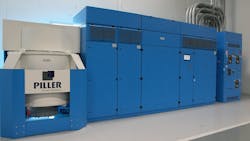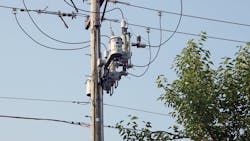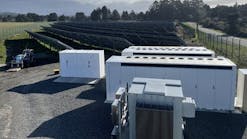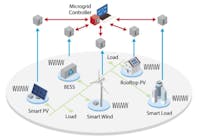Microgrid projects are gaining traction rapidly as a growing number of industries work with utilities to enhance grid resilience and integrate renewable energy sources. For instance, when G&W Electric, a power equipment manufacturer, decided to implement its own microgrid, the first call it made was to its local utility, Commonwealth Edison Co. (ComEd). This pioneering collaboration not only sheds light on the intricacies of deploying microgrids but also offers valuable insights for any utility considering similar projects.
G&W Electric started down the microgrid path after experiencing a glitch in its power system in 2017, which caused significant downtime in its molding facility, leading to tens of thousands of dollars in lost production, added maintenance and discarded materials. By working closely with ComEd to install a microgrid on its campus, G&W Electric sought to provide uninterrupted, premium power and shield against the potential havoc of external grid failures. The endeavor provided a unique scenario because it was the first microgrid project of its kind for both the utility and manufacturer.
The project ultimately included a 2-MW rooftop solar array; battery storage system with four 500-kW blocks; 2-MW diesel generator for prolonged outages; flywheel that detects outages in one-fourth of a cycle and dispenses backup power while the battery or diesel generator come on-line; medium-voltage switchgear; and pole-mounted reclosers that enable a rapid transfer to an alternate power source within 10 seconds of a primary feeder failure.
ComEd’s proactive involvement and guidance proved critical to this complex project’s success. The utility took six key steps with its partner to ensure implementation success and learned several lessons along the way.
Step 1: Assemble the Team
The journey toward microgrid implementation began with assembling a dedicated project team of engineers, project managers and other members from ComEd and G&W Electric. Fostering close collaboration between the equipment manufacturer and utility from the outset laid a solid foundation
for project success.
The ComEd team was on-site in G&W Electric’s labs on a regular basis to understand the microgrid components and how they would communicate with the utility’s equipment. From there, the utility could create prototypes, perform testing and validate its findings before linking the microgrid to the external grid.
Step 2: Set Scope And Agreement
Defining the project scope and securing an interconnection agreement were critical milestones in the project road map. ComEd spearheaded feasibility and system impact studies, crucial precursors to drafting the interconnection agreement. G&W Electric provided input on the assets that would be part of the microgrid, and ComEd conducted studies to assess the impact of the microgrid on its system. This collaborative approach ensured the microgrid seamlessly integrated into ComEd’s infrastructure. While the specifics may vary, such studies are indispensable for microgrid projects. And since the interconnection agreement must be submitted, reviewed and approved before construction starts, it is important to have all the proper documentation in place beforehand.
ComEd and G&W Electric worked in lockstep to define the scope of the project and determine how to integrate the communication between the utility’s equipment and microgrid using a proprietary peer-to-peer protocol ComEd had not previously deployed for this type of project.
Creating a prototype was essential to providing an understanding of how the scheme would work. Before performing any of the scheme changes on the line that served G&W Electric, ComEd conducted a significant amount of lab work to validate the project was operationally sound.
Step 3: Conduct Studies
ComEd and G&W Electric conducted studies focusing on distinct aspects of the project. The utility evaluated the impact of integrating renewable energy sources, such as solar and batteries, into the external grid. G&W Electric’s studies revolved around fault detection and isolation within the microgrid, critical for maintaining grid integrity and protecting microgrid assets. Understanding the nuances of these studies is essential for utilities contemplating similar projects.
The bottom line for other utilities setting out to link to and support industrial microgrid projects: Be prepared to conduct studies, learn iteratively and then do the study again until all outstanding questions are addressed. Even more than with most projects, measuring twice and cutting once during microgrid planning will head off frustrating implementation delays.
Step 4: Overcommunicate
Clear, effective communication and role definition were paramount to the success of this collaboration. In fact, the importance of clearly communicating the plan, roles and responsibilities of all stakeholders cannot be overstated. Clearly defined roles and responsibilities will mitigate confusion and help team members to execute their assigned duties.
Bring the grid operators into the fold early in the project. Even though they will not be implementing the microgrid itself, they are the ones who see the alarms and need to understand how to effectively work with the utility when issues arise. For this project, ComEd created detailed presentations for grid operators, outlining alarm protocols and response procedures. This ensured the operators were well-versed in their roles and responsibilities across various scenarios.
Meanwhile, ComEd focused on the question of how best to manage communication with a customer-owned device when challenges arise. How should the response actions be divided up? Who should own what? It was an ongoing discussion and learning process. When a project integrates utility-owned and customer-owned equipment, it melds together, requiring both parties to understand clearly what steps each will take to resolve problems together.
Step 5: Test, Test, Test
Rigorous testing of the equipment’s connectivity and communication protocols constituted a substantial portion of the microgrid implementation process. Multiple rounds of testing occurred both at ComEd’s labs and on-site. The objective was to validate the communication and protection schemes. This phase uncovered its fair share of challenges, underscoring the importance of thorough testing in microgrid projects.
In preparation for the go-live date, ComEd set up a testing protocol of all the major scenarios the utility had to run through and validate before it could approve bringing the system on-line. As part of the process, ComEd created a detailed checklist to ensure all required testing was covered.
Once again, communication was key to ensuring the utility accomplished everything it needed to do on the go-live day. It was not a scenario where the parties could call off the project and come back the next day. Collaboration was vital.
Step 6: Transition To Live
On the day the microgrid was scheduled to energize, ComEd was on hand to test and ensure the reliability and safety of the grid. ComEd and G&W Electric had a limited time frame to perform final
testing on the go-live date.
While the G&W Electric facility was off the grid and self-islanding on generators before the launch, ComEd ran through all the possible operations and scenarios. Using multiple relay test sets enabled the utility to inject voltage and current to make the equipment think a fault condition was occurring. That allowed ComEd to validate the microgrid was completing the sequence of operations required when it sees fault conditions, including communicating the correct information to the G&W Electric gear, which was confirmed to properly act on that information.
Critical findings included making sure the customer solar inverters would shut down when grid power is lost. When grid power is shut off, ComEd linemen cannot start troubleshooting until they test the line to ensure it is dead. If a solar facility starts generating power onto what is thought to be a deenergized line while linemen are working on it, the results would be catastrophic.
This step required additional testing protocols to account for the fact the microgrid was communicating to two automation devices, G&W Electric Viper reclosers. Testing ensured that if one Viper recloser sees a certain condition, it communicates the status to the other Viper recloser as well as the G&W Electric Trident gear — and that those devices then respond accordingly.
Once those tests were completed, ComEd validated the devices responded appropriately to the simulated conditions and operated correctly. The utility further confirmed G&W Electric’s microgrid operators were receiving correct statuses through their supervisory control and data acquisition (SCADA) monitoring interface and could control the devices properly.
Challenges Faced
The project was successfully brought on-line despite the tight time frame and steep learning curves. To be sure, throughout the project challenges emerged that can offer valuable insights for other utilities and their partners on future microgrid initiatives.
The project encountered communication challenges that necessitated on-the-fly adjustments to fiber connectors. The main challenge was that ComEd’s automation system communicates on a radio network, as the utility is still in the process of transitioning to a fiber network for faster communication. However, it worked with a fiber contractor to run the fiber line needed for this project. These modifications were crucial to ensuring proper functioning of the proprietary peer-to-peer communication protocol. This experience underscores the need for adaptability during microgrid implementation, where unforeseen issues may arise and require swift solutions.
Outdated firmware and software also presented hurdles during the project. These issues were resolved through a twofold approach: updating the firmware for the Viper reclosers in the field and employing modified versions of older software. Staying current with technology emerged as a crucial factor in the
ever-evolving landscape of microgrid development.
In addition, despite rigorous testing at the ComEd lab and G&W Electric facility, teams on both sides decided to conduct synchronized testing of the relay during commissioning to ensure successful execution of the final configuration. This required different test kits for each of three remote switches connected to one master test setup, simulating multiple synchronized fault scenarios. To enable communication with different test kits, Ethernet cables were routed between all three remote test kits to the master test setup, which served as the final operation check of protection settings and communication between the equipment and utility’s SCADA system.
Key Takeaways
ComEd’s work on G&W Electric’s microgrid provides several useful takeaways for utilities venturing into similar projects:
Partner early — Collaboration is key. ComEd’s commitment to work closely with G&W Electric starting in the preplanning phase paved the way for project success. By establishing close communications and coordination at the outset, it was easier to address issues that popped up later in the project. Both of these also helped to foster collaborative problem solving throughout the project’s life cycle.
Know the limitations — The utility should understand and clearly communicate to the microgrid partner any feeder capacity limits to keep a project in proper scale. Feasibility studies are a must.
Test and validate — Safety and project viability are critical. Establish shared protocols and stick to them.
Be nimble — Microgrid interconnects are new terrain for companies and utilities alike. For a successful
implementation, utilities and their partners must demonstrate the adaptability to pivot when needed.
Every microgrid solution requires a holistic, customized approach to meet the needs of both the utility and implementing organization. The lessons shared here can help to prepare utilities for their own successful microgrid projects no matter how unique the implementation turns out to be.
Keyur Kachhiapatel ([email protected]) is a senior engineer on the distribution automation engineering team at ComEd. He started at ComEd by designing relay protection schemes for high-voltage transmission lines and has since transitioned to advanced protection schemes for distribution lines. Some of the pilots Kachhiapatel has contributed to include protection strategies for three-phase to one-phase lateral lines and microgrid protection. He holds a BSEE degree from the University of Illinois, Chicago.
Finny Thomas ([email protected]) is a field engineer on the distribution automation engineering team at ComEd. Thomas has worked on a variety of projects at ComEd, including generic object-oriented substation event testing to enable advanced distribution protection schemes in northern Illinois and ComEd’s REACTs project to test fiber communication throughout the grid. Thomas holds a BSME degree from the Milwaukee School of Engineering.
Kate M. Cummings ([email protected] ) manages distribution automation for switchgear at G&W Electric. She received a BSEE from the University of Illinois at Chicago and has more than 15 years of experience in the power industry at G&W Electric, Ohmite Manufacturing and Maplechase. Cummings is actively involved in several professional organizations, including IEEE, IEEE PES and NEMA. Along with being key in developing and implementing G&W Electric’s microgrid, she also helped to design the Trident-SR controls installed at Lambeau Field in Green Bay, Wisconsin.
Erich Keller ([email protected]) is an engineering manager of power grid automation at G&W Electric. He is responsible for managing power system automation specification, design, factory acceptance testing and site commissioning. Most recently, he acted as chief engineer for integration of G&W Electric’s microgrid at headquarters. Before joining G&W Electric in 2011, Keller was employed at ZIV USA in Des Plaines, Illinois. He received a BSEE degree from Valparaiso University and an MSEE degree from the Illinois Institute of Technology.






